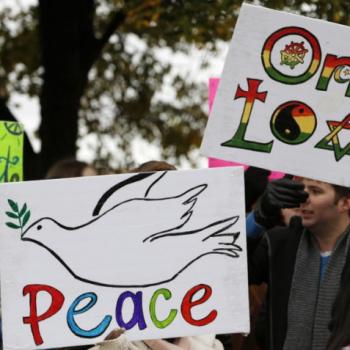Conversations With Jesus: The Daughters of Jerusalem
Luke 23: 26 – 31
I’ve tried and tried to imagine this week what it must have felt like to be among the “daughters of Jerusalem” as Jesus calls them in today’s Gospel passage from the Gospel of Luke. There they found themselves that day, crushed in among the crowd of folks who lined the road and followed along behind Jesus up the hill toward Golgotha—the place of the skull—the place he would die.
So, picture the scene: Jesus was being led up the hill to be crucified. Hoards of people—mostly tourists from out of town—gathered along the roadside to watch the horror unfold. Remember that Jerusalem was normally a fairly substantial city, with about 30,000 permanent residents. But during Passover, when the drama of Jesus’ arrest and crucifixion happened to be taking place, the population would have swelled to about ten times its normal size. Visitors to town didn’t know the back-story; they didn’t share in the political maneuverings of the city’s leaders; many of them probably had never even heard of Jesus. They just gathered along the roadside as humans are want to do whenever there is something terrible unfolding—even if—especially if—the major players in the drama are strangers.
You can hold the horror off at a distance that way.
But such was not the case for a group of women who followed along, pressed in the crowd, sobbing hysterically as was the grieving custom of that time and culture. Luke is the only Gospel writer who includes the daughters of Jerusalem in his passion narrative, but there they were, sobbing, following, watching in horror.
And what horror they would have seen. Luke’s passion narrative is comprised of chapters 22 and 23, where he tells the whole story in graphic, multi-layered detail. It begins with Jesus and his disciples making plans to celebrate the Passover together, all the while one of the disciples Judas Iscariot is hatching a plan to betray Jesus to some of the leaders of the temple who wanted desperately to get rid of him. The disciples finish their meal and go with Jesus to the Mount of Olives, where all the arrest and betrayal drama unfolds. Jesus spends that night in custody, enduring humiliation and cruelty from those who were guarding him, then he appears before the leaders of the temple early the next morning to be tried.
The temple leaders take Jesus to Pilate, the Roman ruler, to ask for Jesus’ execution—Pilate was the only one who could make sentence someone to death. Then the crowd gets involved. The Roman guards, under the direction of Pilate, strip and brutally whip Jesus in the Roman custom that would have left him perched certainly on the edge of consciousness, if not death itself. Then they handed him a heavy, heavy crossbeam, the piece of wood on which he would die, and forced him to begin carrying it up the hill toward his crucifixion. And this is where we find ourselves today in Luke’s account.
Forcing a battered prisoner to carry his cross was a very common strategy in Roman-ruled Jerusalem. The thought was that the crowd gathered there, watching the scene unfold, would be sure to be deterred in any plans for criminal activity once they saw the pain and humiliation of the prisoner on his way to his death. (Anything about this sound familiar??) But on this day it was clear: there was no way Jesus would ever be able to make his way up the hill in his battered state, and carrying a heavy wooden crossbeam was completely out of the question.
So the guards scanned the crowd to find someone to carry the cross, and that’s how Simon, who surely was one of the uninvolved bystanders watching in horror, got conscripted. We don’t know too much about Simon, who most think was a stranger to the situation because he was from out of town, from Cyrene—a little village on the north coast of what we know as Libya today.
Where were the disciples, we might be wondering? Remember those guys who were Jesus’ faithful followers and who had sat around a table sharing a meal with him only the night before? Where were those guys who promised and promised they would never leave him? They weren’t there, that’s for sure. Only a visiting stranger could be found to carry Jesus’ cross. But the women? The women were there. And the grief they felt as they witnessed Jesus’ pain and humiliation birthed in them raw sobs and sharp cries that surely echoed through the hushed horror of the crowd around them.
Just think for a minute about all the layers of grief they carried. They must have felt shame at the absence and betrayal of their male colleagues . . . in refusing to leave and hide with the men, the women surely felt even more powerless and exposed in the presence of the pain and abuse their friend Jesus was suffering right in front of them . . . their hearts were certainly broken as they watched the dreams Jesus had nurtured in their lives torn away right before their eyes; he was a man who valued them, and they knew it. And they couldn’t look at the scene in front of them without knowing that this was the end—Jesus would die—and along with him, every ounce of hope he represented for them.
Knowing him had surely birthed hopes in their hearts that God was not far off, that God was, in fact, deeply concerned with even them, in a world where they heard only messages that questioned their very value and worth. Yes, there was a lot to cry about that day. Their grief engulfed them and wound its way through the crowd carried by their anguished cries. They sobbed; they beat their breasts; they lamented the injustice of the moment and, surely, the injustice of just about everything they knew as they followed along up the hill.
I tried to think this week about my first memory of death. I can see it very clearly in my mind’s eye—can you think of yours? I called my mom to check the details; this probably happened when I was in about third grade.
For many years, my parents hosted a neighborhood afterschool Bible club called Good News Club. Every Thursday afternoon at four we would gather in the garage and hear Bible stories and stories about missionaries all over the world, then we’d be invited to accept Jesus as our Savior.
I got saved so many times I could never remember how many exactly.
The teachers of Good News Club were Mr. and Mrs. Shaeffer, an older couple who were missionaries to the great, pagan wilderness of Hawaii from the civilized and definitely Christian town of Falls Church, Virginia. Mrs. Shaeffer would stand up at the felt board and teach every week, and Mr. Shaeffer would sit in the back corner of the garage in a folding beach chair, snoring.
Sometime during the years of Good News Club, Mr. Shaeffer died. I can’t remember how, exactly, but I do remember that my sisters and brothers and I all accompanied our parents to his funeral. There we sat, in the second row, eyes peering above the pew in front of us right into the open casket of Mr. Shaeffer, who lay there pale and still as could be, while everyone prayed and sang and talked in hushed tones. Mrs. Shaeffer didn’t cry, I remember. She just sat there, looking like her regular Good News Club teacher self, singing the hymns with gusto and nodding when the pastor said Mr. Shaeffer was in a better place (I remember wondering what place that might be…after all, we lived in Hawaii). White flowers—that’s what I remember all around. White flowers everywhere. And quiet, quiet voices. During the service we all stayed as still as we could, I remember, while we pinched each other at the sight of Mr. Shaeffer lying in the coffin, dead.
I never heard anybody talk about Mr. Shaeffer after that day. We still had Good News Club; I still got saved every week. But nobody sat in that chair in the back corner, and somehow I knew it was not appropriate to mention him. It was over and we had to move on.
I learned from attending Mr. Shaeffer’s funeral that just the right way to grieve was to stoically bear the pain of life, somehow acquire a lot of white flowers, speak in a really, really soft voice, and be thankful to God for this better place, wherever that was.
Strikingly, this memory stands in sharp contrast to a later experience I had of death. I lived in a boarding school for girls of Maori descent in Auckland, New Zealand for the high school year I was an exchange student there. One of my classmates had an older brother—maybe 19?—who died tragically in a gang fight. Some of us went to the funeral, you know, for the cultural experience.
We all stayed overnight in the tribe’s community house, sleeping on the floor, on chairs, wherever we could find a spot, along with hundreds of family members and friends. The body of our friend’s brother lay in the middle of the crowd, battered and bruised and also still as could be. Bob Marley blared from a boom box in the corner, and all night long a parade of women came in and out of the lodge crying, wailing, beating their breasts, howling with the unfairness of it all. And the next day, at the grave? More wailing—gut-wrenching, anguished sobs, his mother throwing herself on the coffin, the pain of letting go tangibly present in the air.
For months after that experience, we would blast Bob Marley in the halls of our dormitory, dance around remembering that funeral, and pass the Kleenex along to our friend who cried as she danced and told us stories of all the mischief she and her brother made together as children.
What was the right way to grieve? I was confused. I wouldn’t know for sure, of course, until I was the one on the front row grieving myself. I recall that though all evidence pointed to the conclusion that I myself was still alive, I felt like I was dead, too. And there was no way I could keep quiet or stay still or even tolerate the well-meaning theology of so many.
The truth of the matter, as we all know, is that everyone grieves in his or her own way; there’s no formulaic way to prescribe the grieving process. But I do know this: even with white flowers and hushed conversation, there’s nothing about grief that contains itself to one moment. Grief is a conversation, it’s an ongoing act of remembering and lamenting and understanding the basics then asking why one more time. Grief is loud questions shouted at the sky, desperate inquiries about everything that has happened and what on earth you should have said before and why, why, why this could ever be happening? Grief is . . . grief is like the women who stumbled up the hill—horror-filled and pain-strewn and gut-wrenchingly hard.
Jesus knew that. Somehow Jesus knew. And even at this desperate moment in his life he managed somehow to look over his shoulder, probably with the greatest amount of effort and pain, and engage the women’s grief. He talked to them about their pain. He recognized their anguish. He began with them the conversation that would be the soundtrack of their lives after he was gone.
Jesus had come, you see, not just for that culture and that time in history and that very moment of stumbling progress up a steep hill. He knew the destruction of Jerusalem was immanent and the women who wailed in grief in that moment would cry and cry and cry their hearts out before this was all over.
The question he left with them seemed to be this one: “What will you do with this grief?” My destiny is a foregone conclusion . . . I am already halfway up this hill and we all know what waits at the end. When you turn away from the horror, when you can finally pull yourself back to the reality of the here and now, when you go home tonight to your families and your lives and all the responsibilities that await you . . . what will you do then??!?
The truth is, I don’t quite know what to make of this conversation of Jesus and the women who followed him up the hill. Who ever knows the right thing to say when horror and pain come to rest in one’s life? But the thing that strikes me so deeply about this passage is the raw fact of engagement. Instead of turning away, covering his ears, ignoring the drama behind him, Jesus took a moment to stop, turn around, and acknowledge the grief of the women who followed him up that hill.
In doing what he did, in engaging them in conversation, he validated their grief and gave them permission to feel what they inexplicably felt in that moment. He gave them permission to grieve, and he also began a conversation that would narrate their grief in the days ahead. Jesus knew the pain they felt would never be contained to the horror of this one moment. He knew about his death and their own fear and, later, the very destruction of their city.
Most of all, though, I think Jesus knew that this life we live is punctuated by grief many times over. All different kinds of pain and grief come to visit our vulnerable human lives, and with the limited resources we have, we will always, ever, struggle to make sense of the pain we carry. Grief is not a one-time event; grief is a conversation that, in many ways, lasts our whole lives long. It is surely punctuated with joy and healing, but the pain and wondering doesn’t ever fully release us, does it?
Thanks be to God that we do not wail our way up the hill of life alone. In the middle of his own anguish and pain, Jesus turned to engage the daughters of Jerusalem, to validate their grief and name their pain, to challenge them to keep walking in and through the anguish they felt, to remind them that they never, ever took one step—not one step—alone. God was there. God was engaged. God would not leave them.
Sometimes the conversations that thread through our lives are blithe, funny, inspiring, meaningful. But sometimes they are gut-wrenching sobs of desperate loneliness and hope-void pain. As he wandered our pain-filled earth, Jesus the great conversationalist reminded us that God is not ignorant of even these moments of desperate grief in our lives; that the divine conversation continues even when it is punctuated by sobs; that God wants more than anything to engage us, even in our darkest, most grief-filled moments.
And most of all: that there’s no road in all this human life that we ever have to walk all alone.
Thanks be to God.
Amen.











